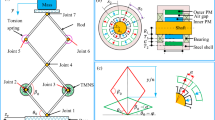Abstract
In this study, the structural control strategy utilizing a passive tuned mass damper (TMD) system as a seismic damping device is outlined, highlighting the parametric optimization approach for displacement and acceleration control. The theory of stationary random processes and complex frequency response functions are explained and adopted. For the vibration control of an undamped structure, the optimal parameters of a TMD, such as the optimal tuning frequency and optimal damping ratio, to stationary Gaussian white noise acceleration are investigated by using a parametric optimization procedure. For damped structures, a numerical searching technique is used to obtain the optimal parameters of the TMD, and then the explicit formulae for these optimal parameters are derived through a sequence of curve-fitting schemes. Using these specified optimal parameters, several different controlled responses are examined, and then the displacement and acceleration based control effectiveness indices of the TMD are examined from the view point of RMS values. From the viewpoint of the RMS values of displacement and acceleration, the optimal TMDs adopted in this study shows clear performance improvements for the simplified model examined, and this means that the effective optimization of the TMD has a good potential as a customized target response-based structural strategy.
Similar content being viewed by others
References
Kwok K C S, MacDonald P A. Wind-induced response of Sydney tower. In: Proceedings of First National Structural Engineering Conference, Sydney, Austrailia, 1987, 19–24
Kwok K C S, Samali B. Performance of tuned mass dampers under wind loads. Engineering Structures, 1995, 17(9): 655–667
Lu X, Chen J. Mitigation of wind-induced response of Shanghai Center Tower by tuned mass damper. Structural Design of Tall and Special Buildings, 2011, 20(4): 435–452
Chung L L, Wu L U, Yang C S W, Lien K U, Lin M C, Huang H H. Optimal design formulas for viscous tuned mass dampers in windexcited structures. Structural Control and Health Monitoring, 2012, (in press)
Villaverde R, Koyama L A. Damped resonant appendages to increase inherent damping in buildings. Earthquake Engineering & Structural Dynamics, 1993, 22(6): 491–507
Sadek F, Mohraz B, Taylor A W, Chung R M. A method of estimating the parameters of tuned mass dampers for seismic applicatins. Earthquake Engineering & Structural Dynamics, 1997, 26(6): 617–635
Wong K K F, Chee Y L. Energy Dissipation of Tuned Mass Dampers during Earthquake Excitations. Structural Design of Tall and Special Buildings, 2004, 13(2): 105–121
Ueng J M, Lin C C, Wang J F. Practical design issues of tuned mass dampers for torsionally coupled builings under earthquake loadings. Structural Design of Tall and Special Buildings, 2008, 17(1): 133–165
Ikago K, Saito K, Inoue N. Seismic control of single-degree-offreedom structure using tuned viscous mass damper. Earthquake Engineering & Structural Dynamics, 2012, 41(3): 453–474
Bernal D. Influence of ground motion characteristics on the effectiveness of tuned mass dampers. 11th World Conference on Earthquake Engineering, 1996, Paper No. 1455
Soto-Brito R, Ruiz S E. Influence of ground motion intensity on the effectiveness of tuned mass dampers. Earthquake Engineering & Structural Dynamics, 1999, 28(11): 1255–1271
Murudi M M, Mane S M. Seismic effectiveness of tuned mass damper (TMD) for different ground motion parameters. 13th World Conference on Earthquake Engineering, 2004, Paper No. 2325
Den Hartog J P. Mechanical Vibrations. New York: McGraw-Hill, 1956
Crandall S H, Mark W D. Random Vibration in Mechanical Systems. Academic Press, 1963
Randall S E, Halsted D M, Taylor D L. Optimum vibration absorbers for linear damped systems. Journal of Mechanical Design-Transactions of the ASME, 1981, 103(4): 908–913
Warburton G B. Optimum absorber parameters for various combinations of response and excitation parameters. Earthquake Engineering & Structural Dynamics, 1982, 10(3): 381–401
Hoang N, Fujino Y, Warnitchai P. Optimal tuned mass damper for seismic applications and practical design formulas. Engineering Structures, 2008, 30(3): 707–715
De Angelis M, Perno S, Reggio A. Dynamic response and optimal design of structures with large mass ratio TMD. Earthquake Engineering & Structural Dynamics, 2012, 41(1): 41–60
Ziyaeifar M, Gidfar S, Nekooei M. A model for mass isolation study in seismic design of structures, Structural Control and Health Monitoring, 2012 (first published online)
Moutinho C. An alternative methodology for designing tuned mass dampers to reduce seismic vibrations in building structures, Earthquake Engineering & Structural Dynamics, 2012 (first published online)
Wolfram S. Mathematica — A System for Doing Mathematics by Computer. 2nd ed. Boston: Addison-Wesley Publishing Company Ltd, 1991
Charng P H. Base isolation for multistory building structures. PhD Thesis, Department of Civil Engineering, University of Canterbury, Christchurch, New Zealand, 1998
Pan T C, Cui W. Response of segmental buildings to random seismic motions. ISET Journal of Engineering Technology, 1998, 35(4): 105–112
Kobayashi M, Koh, T. Earthquake response prediction and rationalization of dynamic design of mid-story isolated buildings. Journal of Structural Construction Engineering, Architecture Institute of Japan, 2005, No. 592: 31–57 (in Japanese)
Chey M H, Chase J G, Mander J B, Carr A J. Semi-active tuned mass damper building systems: application. Earthquake Engineering & Structural Dynamics, 2010, 39(1): 69–89
Author information
Authors and Affiliations
Corresponding author
Rights and permissions
About this article
Cite this article
Chey, MH., Kim, JU. Parametric control of structural responses using an optimal passive tuned mass damper under stationary Gaussian white noise excitations. Front. Struct. Civ. Eng. 6, 267–280 (2012). https://doi.org/10.1007/s11709-012-0170-x
Received:
Accepted:
Published:
Issue Date:
DOI: https://doi.org/10.1007/s11709-012-0170-x




